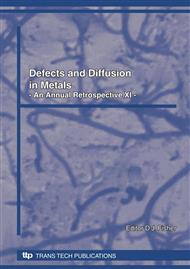p.63
p.67
p.71
p.77
p.83
p.91
p.99
p.107
p.113
Non-Ohmic Behavior of Some ZnO Ceramic Defective Ions with Different Valences
Abstract:
ZnO ceramic samples with the chemical formula, 97ZnO-2BaO-1(X)Mol% (where X= CuO, Fe2O3, TiO2, V2O5, MoO3) have been prepared by using conventional ceramics techniques. The samples were sintered at 1200°C for 1, 1.5 or 2h. The metal ions were chosen such that their ionic radii were just slightly different, whereas their ion valences varied from 2+ in case of Cu to 6+ for Mo. Room-temperature I-V characteristics, microstructures, linear scans and X-ray patterns were then studied. The microstructure and linear scan data revealed that, in the case of Cu-, Fe-, V- and Mo-doped ceramics, the doped ions resided mainly at the grain boundaries while, in case of Ti-doping, the ions resided mainly in the grain interior. The electrical measurements and the linear scan data showed that both the non-linearity parameter, α, and the rate of change of α with sintering time, (dα/dt), was exponentially proportional to the valence of the doped ion, where t is a sintering time in the range of 1 to 2h. The leakage current, JL, is linearly proportional to the amount of doped ion present in the grain interior, relative to that present at the boundaries. The X-ray data revealed that the obtained phase was the hexagonal ZnO phase, with traces of secondary phase related to the doped ion; the secondary phases were identified as being Fe2O3, BaTi5O11, Zn3(VO4)2 and (ZnMoO4) in case of Fe-, Ti-, V- and Mo-doped ceramics, respectively. The relative intensity of the X-ray peak at 2θ = 34.45, corresponding to the (0002) plane, was exponentially proportional to the valence of the doped ion; while α scaled with the relative intensity of the aforementioned X-ray peak.
Info:
Periodical:
Pages:
91-97
Citation:
Online since:
August 2009
Authors:
Price:
Сopyright:
© 2009 Trans Tech Publications Ltd. All Rights Reserved
Share:
Citation:


